Soil Temperatures – Current, Departure from Normal, and Forecast
We often use 60°F at planting depth in Kansas as our baseline temperature. As of April 25, the statewide average 7-day 2-inch soil temperature is 57.3°F or 0.3°F below normal. Soil temperatures have fallen 2.5°F since April 15, thanks to cooler weather (Figure 2). Air temperatures in the last 10 days have averaged 4.5°F below normal statewide. The southern third of Kansas currently has the warmest soil temperature readings, averaging between 59°F and 61°F. Parts of Kansas are finally receiving significant rainfall, but the clouds and rain mean air and soil temperatures are likely to remain below normal. The 6 to 10-day outlook calls for cooler-than-average temperatures to continue into the beginning of May (Figure 3). The average date on which the statewide 7-day average soil temperature first reaches and remains over 60°F is May 6, but reaching and maintaining that threshold will likely be delayed this year.
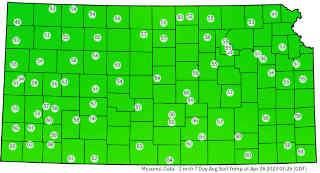
Figure 1. Average 7-day 2-inch soil temperatures as of April 26, 2023. Data and image courtesy of Kansas Mesonet (mesonet.k-state.edu).
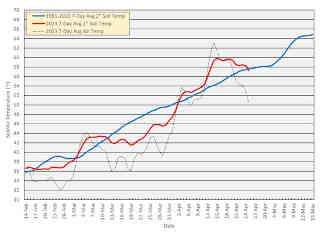
Figure 2. 30-Year average 2-inch soil temperature, 2023 average 2-inch soil temperature, and 2023 average air temperature. Average data plotted are 7-day values. Dates plotted represent the last day of the 7-day average period (e.g., plotted data for April 25 are the 7-day averages for the period April 19th-25th. Graph created by Matthew SIttel, K-State Research and Extension.
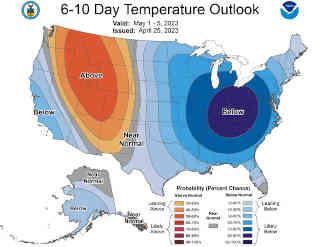
Figure 3. The Climate Prediction Center’s 6 to 10-day temperature outlook for the period May 1-5, 2023. Source: cpc.ncep.noaa.gov.
In addition to considering soil temperature, growers should be planting high-quality varieties (e.g. high cold germination and large seed size, with good cold tolerance and early season vigor ratings).
Information from North Carolina State University’s cotton web page illustrating the importance of heat unit accumulation immediately following planting is shown in Table 1.
Table 1. Relationship between predicted DD-60s and Planting Conditions (Source: North Carolina State University, https://cotton.ces.ncsu.edu/)
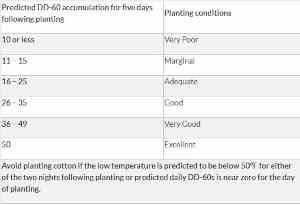
Effects of cold soil on cotton seeds
Cotton seed subjected to cold the first 2-3 days after planting, OR when the seed is imbibing moisture from the soil, is susceptible to imbibitional chilling injury. The greatest sensitivity is during the first day after planting as water is being imbibed (Hake et al.) as shown in Figure 4.\
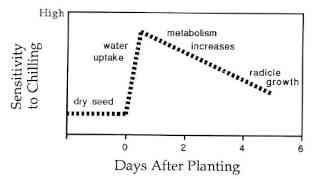
Figure 4. Relative sensitivity of cotton to chilling in the first several days after planting. K. Hake, W. McCarty, N. Hopper, and G. Jividen.
Cotton seeds contain lipids which must be converted to energy, and cell membranes must develop properly. Seedlings may suffer damage if soil temperatures drop below 50°F during this critical germination period. The first 30 minutes after planting, the seed will absorb up to 60% of the water necessary for germination. Cold soil temperatures (<45°F to 50°F) will most likely lead to injury or seedling death. Damage may result in malformed seedlings, loss of or damage to the taproot, and a greater likelihood of seedling disease problems. Injury usually kills the root tip meristematic tissue which stops normal taproot growth and leads to lateral root development (Figure 5). If the plants survive, the root system will not develop normally. Additionally, reductions in yield have been documented when there are less than 25 heat units received in the first 5 days after planting. For these reasons, it’s critical that cotton be planted into a warming soil temperature trend.
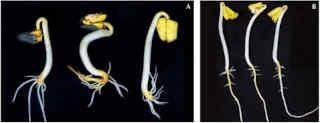
Figure 5. Cotton seedlings subjected to chilling temperatures (A) compared to seedlings not chilled (B) during imbibition from a study conducted by Hopper and Burke. Note the absence of normal taproot growth of the seedlings in A. Seedlings in A and B were exposed to the same temperature (86°F) with the exception of the first six hours of imbibition in which seedlings in A were exposed to chilling temperatures of 40°F. Photos by N. Hopper, Texas Tech University, and J. Burke, USDA-ARS, Lubbock, TX.
Seed Quality
Cotton production in Kansas is typically thermally limited, with slower warming in soil temperatures and higher levels of surface residue present compared to other cotton-growing areas. It is especially important that producers plant cotton seeds with exceptional seed quality and understand both their warm and gold germination scores on their seed lots. Warm germination scores are standardized across the industry and are required by law on seed tags. Cold germination tests are not required by law but are available from reputable seed companies. Be cautioned, that cold germination test procedures are not necessarily uniform across companies. Be sure to ask and understand what methodology was used before comparing cold germination scores across companies. In general, producers should plan to plant cotton seeds with the lowest cold germination scores first. In general, cold scores greater than 85% are preferred for early planting. Some companies may be able to provide the Cool-Warm Vigor Index (CWVI) score for their seed. This test, developed in Texas, gives a score that is the combined percentage of the 4-day warm germination test and the cool germination test. Scores of 160 or greater are excellent, Good = 140-159, Fair = 120-139, and Poor is anything less than 120. Farmers would want to plant seeds with the highest scores first and move to lower-scoring seed lots as soil temperatures increase.
Source : ksu.edu